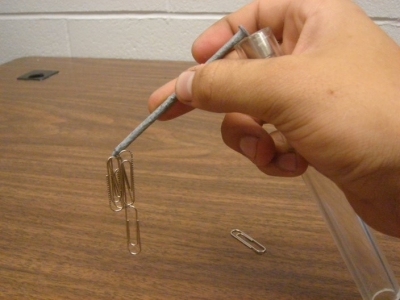
Pulleys are machines that we use to lift heavy objects. They are made from a number of wheels and a long piece of rope or cable. The cable is wound around each of the wheels in turn, and the whole system is attached to a weight.
By pulling the cable, the weight can be raised easily. The more wheels in a pulley system, the easier the lifting becomes. When three pulleys are used, the weight is shared between three stretches of cable and the force you need is only a third of what you would need to lift the weight by yourself. If four were used, the force you would need would be reduced to a quarter.
Fixed
The wheel of a fixed pulley system is attached to a solid structure such as a wall or a floor, while the rope is free. This means the pulley itself is stationary. A fixed pulley offers no mechanical advantage but does allow a person to redirect the force. So rather than directly lifting a heavy object up, a person can use a pulley to instead lift the object by pushing down on the rope.
Moving
The wheel of a moving pulley is not attached to any particular surface; instead, the rope of the pulley is attached to a stationary surface. Unlike a fixed pulley, a moveable pulley does offer a mechanical advantage. A heavy load is attached to the wheel rather than the rope, and as the rope is pulled the wheel slides up the rope, bringing the load with it. This requires less work than lifting the load directly would require.
Compound
A compound pulley consists of both a fixed pulley and a moveable pulley. This combines the benefits of both a fixed and a moveable pulley. In a compound pulley the weight is attached to the wheel of a moveable pulley, which itself is strung to a rope attached to a fixed pulley. With a compound pulley you can redirect the required direction of the force as well as the total workload for the force.
Block and Tackle
A block and tackle is a specialized form of compound pulley that can dramatically lessen the required amount of work to move a heavy object. A block-and-tackle pulley system consists of several fixed and moveable pulleys arranged parallel with one another; fixed pulleys aligned with fixed and moveable pulleys with moveable. Each compound pair is attached to the next pair, and each set reduces the total work required. This pulley system is popularly attributed to Archimedes, the famous ancient inventor and mathematician.
Cone
The cone pulley is another specialized pulley system that incorporates the basic mechanics of a pulley system while allowing for mechanical adjustments. A cone pulley is essentially multiple pulley wheels of decreasing circumferences stacked on top of one another, forming a cone shape. This cone shape allows the pulley operator to shift the speed of the pulley's movements, with a smaller circumference requiring less work but also producing less work. Multi-gear bicycles essentially operate on this same system; the bicyclist can easily shift between smaller gears that move the bike less, and higher gears that require more effort but move the bike a greater distance per revolution.
Gears
Like pulleys, gears make work easier. Gears are objects which are used to move force from one place to another. The most common gear is the cog — a wheel with teeth. In cars and bicycles, gears are used to help turn the wheels. On a bicycle, a chain moves around two cogs — a large cog attached to the pedals and a smaller cog attached to the back wheel.
As the pedals turn, the large cog rotates, the chain turns and the smaller cog makes the back wheel rotate quickly. If the large cog has twice as many teeth as the small cog, the back wheel will turn twice as quickly when you pedal. The smaller the cog at the rear, the faster you will travel (a high gear). The larger the cog at the rear, the lower the gear.
Picture Credit : Google













 Without liquid water there would be no life on the Earth. No other planet has liquid water, and hence no life is possible on any planet other than the Earth. Water is found everywhere - in milk, vegetables, fruit, meat, air, and ground. Water is the habitat for a large number of plants and animals. Fish, algae, crustaceans, and many more organisms live in the oceans. Frogs jump in puddles and ponds, and sea birds move on the surface of water. Water carries ships, from small boats to giant container ships, which are used for transportation.
Without liquid water there would be no life on the Earth. No other planet has liquid water, and hence no life is possible on any planet other than the Earth. Water is found everywhere - in milk, vegetables, fruit, meat, air, and ground. Water is the habitat for a large number of plants and animals. Fish, algae, crustaceans, and many more organisms live in the oceans. Frogs jump in puddles and ponds, and sea birds move on the surface of water. Water carries ships, from small boats to giant container ships, which are used for transportation.